In the dynamic landscape of contemporary marketing, the strategic alliance between brands has proven to be a formidable catalyst for growth. Cross-promotion, a nuanced approach where non-competing businesses collaborate to tap into each other’s audience, has emerged as a powerhouse strategy.
According to recent industry reports, businesses engaging in cross-promotional activities witness, on average, a 23% increase in customer acquisition. Moreover, the cross-promotion market is slated to grow exponentially, with estimates indicating a compound annual growth rate (CAGR) of 9.8% over the next five years. These statistics paint a vivid picture of the tangible benefits that await businesses savvy enough to harness the potential of cross-promotion.
What is Cross Promotion?
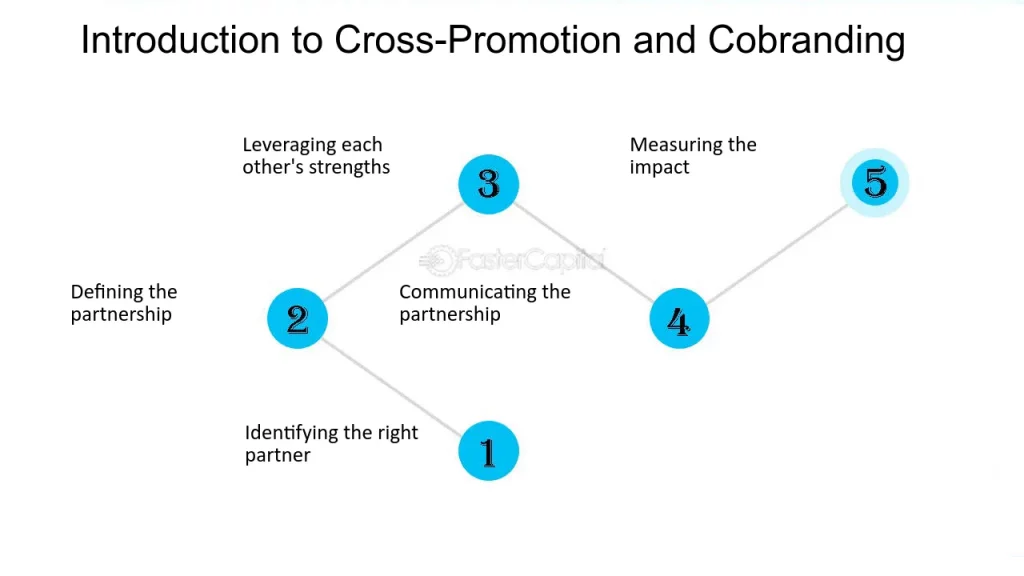
Cross-promotion is a marketing strategy in which non-competitive brands with comparable target audiences collaborate to promote each other’s products or services. This involves reaching and marketing to one another’s audience and promoting a related product or service. The essence lies in connecting diverse brands with potential customers across various marketing channels.
The concept of cross-promotion is vividly illustrated by a notable example from 2007, when McDonald’s strategically featured the beloved character Shrek alongside its products. This collaboration aimed to draw in more customers, and in return, DreamWorks, the company behind the Shrek franchise, reaped substantial exposure and benefits.

Typically, cross-promotion unfolds through collaborations and mutually promoting products or services with other businesses. This cooperative approach allows brands to tap into each other’s audiences, expanding their reach and influence. However, it’s essential to note that cross-promotion isn’t confined to partnerships alone; it can also manifest as self-promotion on new platforms. Cross-promotion involves leveraging synergies to enhance visibility and engage with diverse audiences.
Learn about other types of promotion here.
Benefits of Cross Promotion:
1. Audience Growth: Reaching New Horizons Through Collaboration
One of the foremost advantages of cross-promotion lies in its ability to extend the reach of a brand by tapping into new and diverse audiences. When two non-competing entities join forces, they bring along their respective audience bases. This collaborative effort enables each brand to introduce itself to a fresh set of eyes and ears—audiences that may not have been accessible through traditional marketing channels. The result is a symbiotic relationship where both partners benefit from an expanded and diversified consumer base.
2. Increased Sales: Synergies That Propel Revenue
Cross-promotion isn’t merely about exposure; it’s a strategic alliance that often translates into a tangible boost in sales. By leveraging the strengths of each brand, products or services are presented in a more enticing package. This creates a compelling value proposition for consumers, encouraging them to explore offerings from both collaborators. The synergies generated through cross-promotion can lead to a notable uptick in sales for both parties involved. This collaborative selling approach often outperforms individual efforts, proving that the whole is indeed greater than the sum of its parts.
3. Lower Advertising Costs: A Collective Approach to Savings
In the realm of marketing, budgets are a critical consideration. Cross-promotion offers a cost-effective alternative to traditional advertising by sharing promotional efforts. Rather than investing in separate, often costly campaigns, collaborating businesses pool their resources. This shared approach not only reduces the financial burden on each partner but also allows for more expansive and impactful marketing initiatives. The result is a strategic and economically sound method for reaching a broader audience without the hefty price tag associated with solo advertising endeavors.
4. Increased Brand Awareness: Illuminating the Market Landscape Together
Collaborative ventures in cross-promotion illuminate the market landscape with a brighter, more vibrant presence. By associating with a partner brand, businesses can bask in the shared glow of heightened visibility. The combined marketing efforts, whether through joint campaigns, events, or promotions, amplify the overall brand awareness for both collaborators. Consumers are more likely to remember and engage with brands that appear together, creating a lasting impression that extends beyond the duration of a specific campaign.
Strategies for Cross Promotions:
1. Set cross-promotional goals:
Setting well-defined cross-promotion goals is crucial to ensuring a successful and impactful campaign. Before delving into the promotion process, clearly outline what you hope to achieve through cross-promotion. Your goals should align with your overarching business objectives. They may encompass various aspects, such as increasing sales, extending the market reach of your product, enhancing brand awareness, or fostering a positive brand image.
Consider breaking down your goals into actionable tasks to map out your cross-promotion strategy effectively. Identify the specific actions and initiatives that need to be undertaken to reach each goal. This could include identifying potential collaborators, designing promotional materials, or planning joint events.
In addition to outlining tasks, it’s crucial to establish Key Performance Indicators (KPIs) that align with your cross-promotion goals. KPIs serve as measurable benchmarks that allow you to track the success and impact of your campaigns. These indicators include sales figures, website traffic, social media engagement, and customer acquisition rates. By defining clear KPIs, you can systematically monitor the performance of your cross-promotion efforts and make data-driven adjustments as needed.
To facilitate the goal-setting and tracking process, consider incorporating various plugins and tools designed to streamline and enhance your cross-promotion campaigns. Here are a few examples:
2. Choose an Appropriate Collaborator
Once you’ve established your cross-promotion goals, the next critical step is to meticulously evaluate potential partners to determine which would best align with and contribute to your objectives. Selecting a trustworthy and compatible company operating in a non-competitive space is imperative.
In many successful cross-promotion endeavors, the synergy is heightened when the products or services involved are complementary and contextually relevant. A prime example of this strategic collaboration can be observed in the partnership between Uber and Spotify.
Uber and Spotify Cross-Promotion Case Study

In this instance, Uber’s alliance with Spotify proved mutually beneficial. Both companies capitalized on their respective strengths by allowing users to seamlessly connect their Spotify accounts and play their chosen music through the car’s speakers. Spotify Premium users enjoyed the perk of playing their personalized playlists during their Uber rides, fostering a positive experience.
The collaboration resulted in a symbiotic relationship: More Uber users opted for Spotify Premium subscriptions, and conversely, more Spotify users engaged with Uber by booking rides. This exemplifies the effectiveness of selecting a partner whose offerings complement your own, ultimately maximizing the impact of your cross-promotion efforts.
- Google Analytics: Utilize Google Analytics to track website traffic, user behavior, and conversion rates. This tool provides invaluable insights into the effectiveness of the cross-promotion efforts online.
- Social Media Management Tools: Platforms like Hootsuite or Buffer can help you schedule posts, monitor social media engagement, and analyze performance across different social channels. These tools are invaluable for managing and optimizing cross-promotion content on social platforms.
- Collaborative and Project Management Tools: Tools as Trello, Asana, or Slack can aid in organizing tasks, coordinating efforts with collaborators, and ensuring seamless communication throughout the cross-promotion process.
- Survey and Feedback Tools: Collecting feedback is essential for refining your cross-promotion strategy. Tools like SurveyMonkey or Typeform can help you gather insights from your audience and collaborators to make informed adjustments.
“In the networked economy, the only path that makes sense is to either be the best in the world at what you do, or the only one doing it.”
Marketing guru Seth Godin
3. Leverage Social Media Platforms for Cross-Promotion
Effectively cross-promoting your brand involves strategically utilizing social media platforms to enhance brand awareness and reach a wider audience. While various channels and methods exist for cross-promotion, social media stands out as a versatile and powerful tool to connect with the target audience.
You can cross-promote your brand through diverse avenues, including guest blogs, referral programs, webinars, conferences, and more. However, one of the most impactful strategies is establishing a vital presence on popular social media platforms such as Facebook, Instagram, YouTube, and Pinterest.
To implement a successful social media cross-promotion strategy, collaborate with non-competitive companies and mutually promote each other’s products or services. This approach broadens your reach and fosters engagement with a new audience that may share similar interests.
For instance, Thursday Boots, a company specializing in footwear, executed an effective social media cross-promotion by partnering with Cobbler’s Choice, a brand offering footwear care products. The collaboration was seamlessly integrated into Instagram posts, showcasing the synergy between boots and maintenance products.
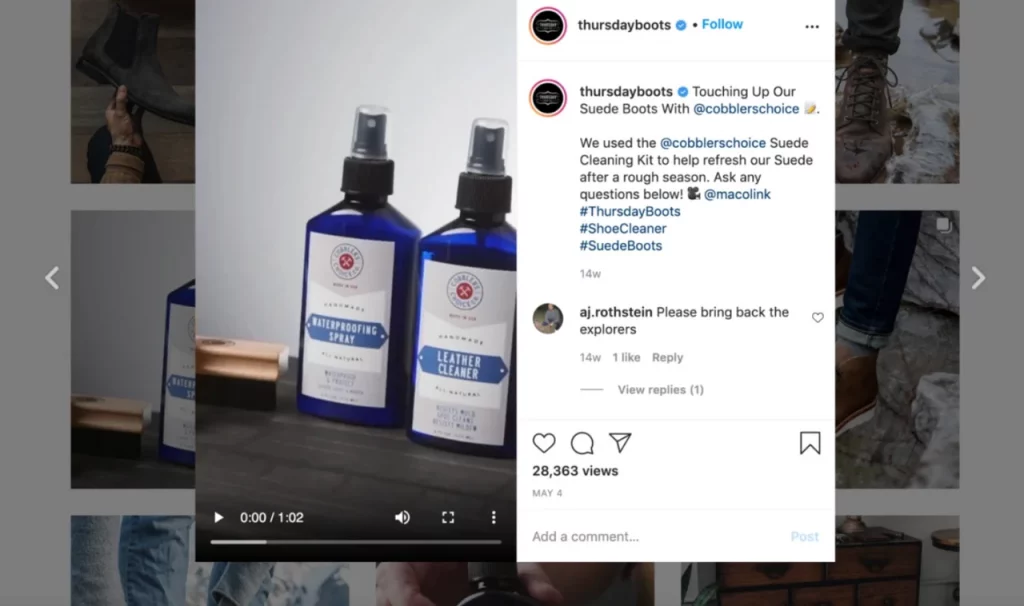
In their Instagram post, Thursday Boots highlighted Cobbler’s Choice Suede Cleaning Kit, incorporating a short video to showcase the product. They tagged Cobbler’s Choice’s account, emphasizing the collaborative effort. In turn, Cobbler’s Choice reciprocated with an Instagram post featuring their Waterproofing Spray alongside a pair of boots from Thursday Boots.

This type of content promotes each other’s products and creates a visually engaging and cohesive narrative for followers. Such collaborations can take various forms, including influencer posts, giveaways, contests, and promotional videos, all designed to capture the attention of a broader audience and enhance brand visibility.
For those venturing into creating a business YouTube channel, additional resources like the article “How to Get Your First 100 Subscribers on YouTube” can provide valuable insights and guidance.
4. Host a Webinar for Effective Cross-Promotion
An excellent cross-promotion strategy involves organizing online events like webinars, particularly advantageous for small business partners, especially those in the SaaS (Software as a Service) and product sectors.
Consider partnering with a business ally to jointly host a webinar, emphasizing that the primary objective isn’t solely focused on selling. Instead, the key aim should be to deliver substantial value to the audiences of both collaborating parties.
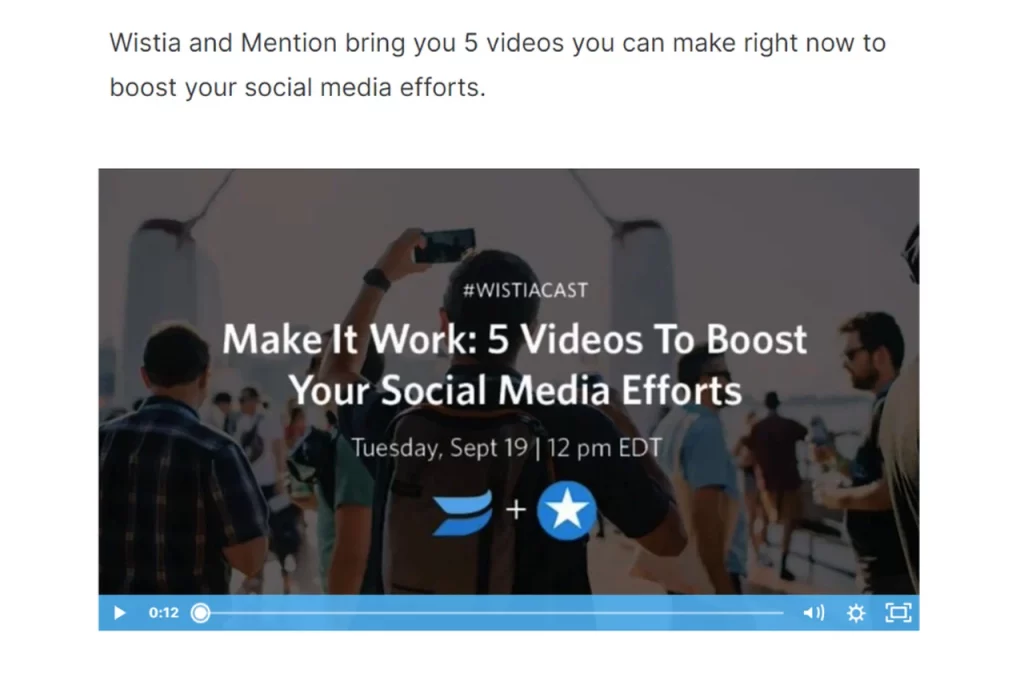
A noteworthy example of this cross-promotion approach unfolded in a partnership between Wistia and Mention. These two companies collaborated to curate a video, ensuring that the content provided valuable insights and benefits to their users. This exemplifies the essence of webinars as a tool for knowledge sharing and mutually beneficial engagement rather than merely a sales-focused endeavor.
5. Collaborate on Ebook Creation for Cross-Promotion Success
Exploring the creation of an ebook in partnership with your business associate can prove to be a highly impactful cross-promotion strategy. This approach is efficient when the overarching goal is delivering substantial value and assistance to users on both ends.
The collaborative process involves pooling expertise, insights, and resources to craft an ebook that addresses common challenges, interests, or needs shared by the audiences of both businesses. This enhances the ebook’s perceived value and broadens its appeal to a broader audience.
Let’s delve into an illustrative cross-promotion example involving the creation of an ebook:
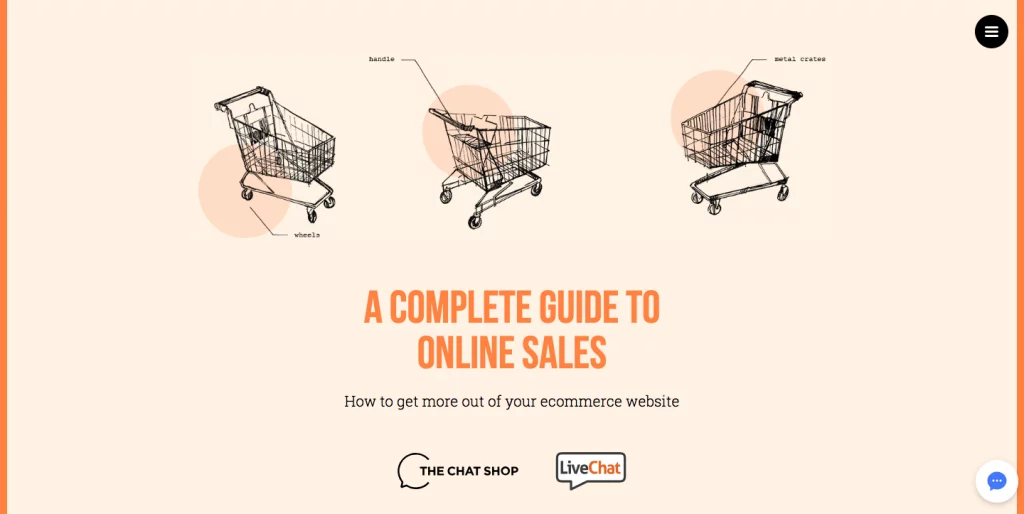
Imagine two companies, TechGuru Solutions, and CreativeDesign Studios, each specializing in different aspects of digital solutions. Recognizing the complementary nature of their offerings, they collaborated on crafting an ebook titled “Digital Mastery: A Comprehensive Guide to Seamless Integration of Design and Technology.”
In this ebook, TechGuru Solutions contributes chapters on the latest technological trends and advancements, while CreativeDesign Studios delves into aesthetically pleasing and user-centric design principles. By combining their expertise, the ebook becomes a holistic resource that educates and seamlessly introduces readers to the capabilities of both companies.
Both companies leverage their marketing channels, such as newsletters, social media platforms, and website features, to promote the ebook. Each partner emphasizes the collaborative effort, showcasing how the ebook encapsulates the synergies between design and technology.
This cross-promotion method elevates brand awareness for TechGuru Solutions and CreativeDesign Studios and positions them as authorities in their respective domains. Furthermore, it fosters a sense of trust among their audiences, as the joint venture signifies a commitment to delivering comprehensive value.
6. Create and Offer Bundles: Amplifying Sales and Brand Awareness
Cross-promotion through creating and offering bundles is a highly effective strategy, mainly when collaborating with a business partner in a similar industry. This approach drives sales and significantly boosts brand awareness for both parties involved.
Bundling involves packaging products or services from different brands, presenting them as a cohesive offering. This strategy leverages each brand’s strengths to give customers a more comprehensive and attractive value proposition. The idea is to create synergies between the bundled items, making the combined purchase more enticing than buying each item individually.
Example: Amazon and The Dot Store’s Bundle Deal
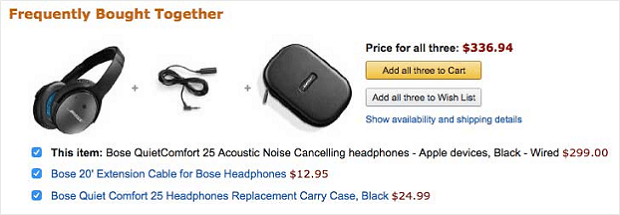
A compelling illustration of successful bundle-based cross-promotion is the collaboration between Amazon and The Dot Store. These two entities, each offering various tech-related products, joined forces to create an enticing bundle deal.
In this scenario, the bundle could include a Dot Store smart home device, such as a smart plug or bulb, paired with an Amazon Echo device. The collaboration showcases the harmony between The Dot Store’s innovative home automation products and Amazon’s voice-controlled smart assistant technology.
7. Create a Referral Program: Harnessing the Power of Word-of-Mouth Marketing
In consumer decision-making, recommendations from friends, family, or colleagues hold significant sway. A Nielsen study underscores this, revealing that these personal referrals remain the most credible form of advertising among consumers. In light of this, leveraging referral programs emerges as one of the most potent ways to promote your company.
Referral programs tap into the innate power of word-of-mouth marketing. When individuals receive product or service recommendations from their trusted social circles, it instills a sense of credibility and trust, often leading to a more favorable buying decision. Understanding this dynamic, businesses can strategically implement referral programs to harness the influence of personal recommendations.
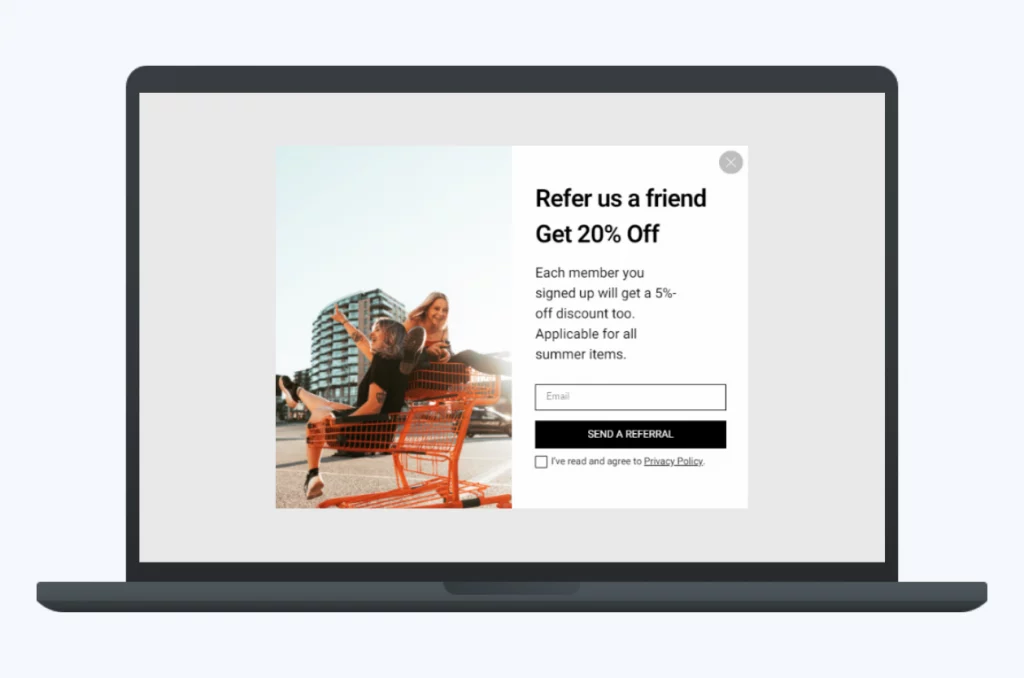
Implementing a Referral Program
- Initiating a Referral Program: Start by launching a structured referral program that incentivizes your existing customers to refer friends, family, or colleagues. Establish a clear process for tracking referrals and sign-ups resulting from these recommendations.
- Rewarding Referrers: Encourage customers to actively share your products or services by offering rewards for successful referrals. This could include discounts, exclusive access, or even monetary incentives for each new member they bring on board.
- Tracking Referrals: Employ robust tracking mechanisms to monitor and attribute successful referrals. This allows you to recognize and reward referrers accurately.
- Popup Referral Prompts: Utilize popups to prompt users to participate in the referral program. Like the example created with Popupsmart popup builder, engaging and well-timed popups can effectively capture user attention and encourage participation.
8. Boost Visibility through Podcast Guest Appearances
A staggering 55% of the US population, equivalent to approximately 155 million individuals, has delved into the world of podcasts. This immense audience presents a golden opportunity for businesses to significantly elevate their visibility by securing a spot as a guest for a popular podcast.
Podcasts offer a multifaceted platform allowing businesses to:
- Introduce to a New Audience: Guest podcast appearances serve as a gateway to unveiling your brand to an entirely new and engaged audience.
- Showcase Expertise: Utilize podcasts to showcase your expertise in your industry, establishing credibility and authority.
- Highlight Company Values and Culture:** Beyond the business aspects, podcasts provide a space to illuminate your company’s values, culture, and Unique Value Proposition (UVP).
Exemplary Cross-Promotion: Blake Mycoskie on The Tim Ferriss Show
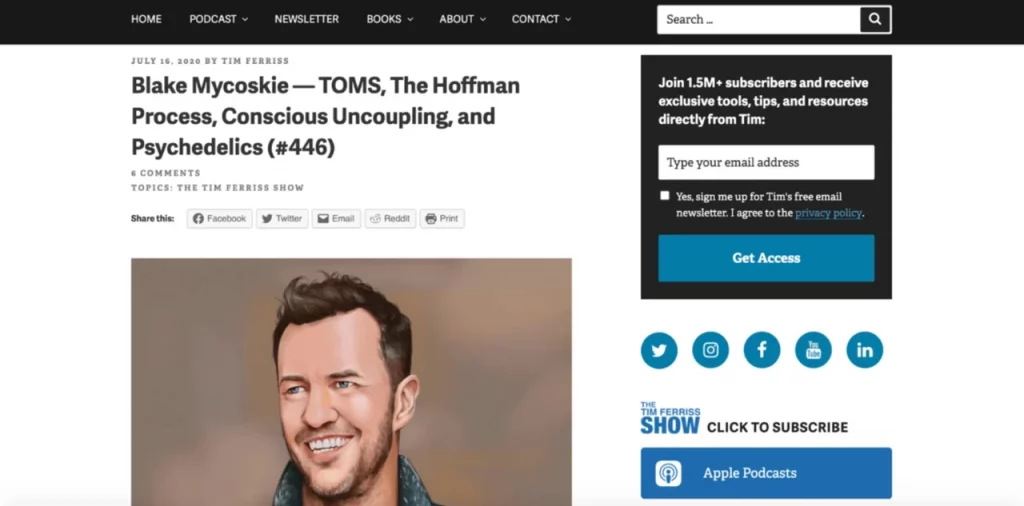
Blake Mycoskie’s feature on The Tim Ferriss Show is a stellar example of leveraging podcast guest appearances for cross-promotion. Tim Ferriss, known for hosting the number one podcast on Apple Podcasts with over 500 million downloads, provided an exceptional platform for Blake, the founder of TOMS and Madefor.
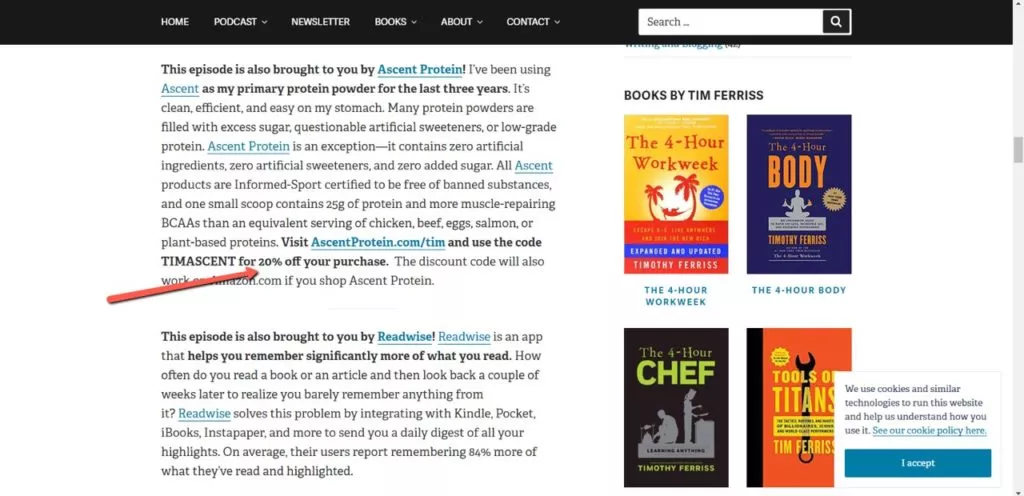
In this strategic move, Blake exposed his brands to Tim Ferriss’s massive audience and collaborated on a promotional offer. The podcast audience received a 20% discount on Madefor monthly plans by entering a specific promo code, creating a tangible and immediate benefit for listeners.
Bonus: Additional Illustrations of Successful Cross-promotion
- Apple Watch Nike
In cross-promotion, the collaboration between Apple and Nike stands out with the creation of the Apple Watch Nike. This joint venture seamlessly blends the technological prowess of Apple with the athletic focus of Nike, capturing consumers’ attention from both realms. The combined features of the Apple Watch and the Nike Run Club app cater specifically to the needs of runners, exemplifying the effectiveness of cross-promotion when catering to related audiences.
- Adidas and IVY Park
Another compelling cross-promotion example unfolds in the partnership between Adidas and IVY Park. This collaboration transcends traditional boundaries by bringing together Adidas’ emphasis on footwear with IVY Park’s focus on clothing. Bolstered by Beyonce’s role as IVY Park’s brand ambassador and influencer, the partnership gains additional momentum through her promotion on social media platforms.
Adidas reciprocates by featuring IVY Park on its official website, solidifying the mutual promotion effort. This successful collaboration underscores the importance of complementary products and shared values in cross-promotion initiatives.
Conclusion:
In conclusion, when approached thoughtfully, cross-promotion can be a catalyst for mutual success and sustained growth. We invite you to share your favorite business partnership examples in the comments below, fostering a collaborative exchange of ideas and inspiration.
However, the crux lies in selecting the right partner— a reliable company that complements rather than competes. The most fruitful cross-promotions often arise when services or products seamlessly align, creating a harmonious partnership. Choosing wisely and maintaining a shared focus on audience relevance can maximize the potential benefits of cross-promotion.
FAQs on Cross Promotions:
Can cross-promotion be done on social media?
Yes, social media is a popular platform for cross-promotion. Brands can collaborate on various social media channels to reach each other’s audiences through influencer posts, giveaways, promotional videos, and more.
Can cross-promotion be done in different industries?
Cross-promotion can be effective across different industries, provided there is a logical connection or complementary aspect between the products or services of the collaborating brands.
Can cross-promotion lead to customer confusion?
While collaboration aims to complement each other, clear communication and branding are crucial to avoid customer confusion. Ensure that messaging emphasizes the partnership’s benefits and maintains brand identity.
Are there legal considerations in cross-promotion?
Yes, legal considerations are essential. Consult legal professionals to draft clear agreements covering intellectual property, liabilities, and any financial arrangements. Ensure compliance with relevant laws and regulations.



